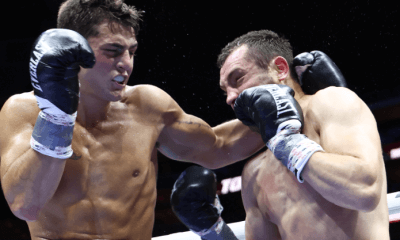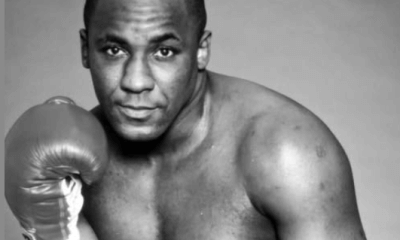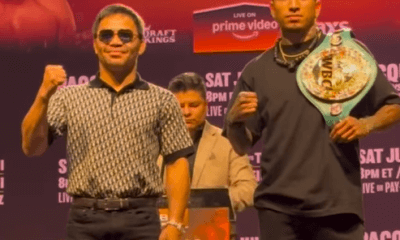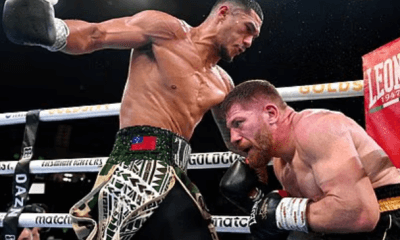Articles of 2004
Middleweight Champs: Never Go Down and Rarely Go Up
Since knocking out Oscar De La Hoya in the signature-fight of his career, while successfully defending his undisputed Middleweight title for a record 19th consecutive time, Bernard Hopkins still hasn't quite silenced all of his critics. Now some of them want him to move up in weight and challenge a defending champion. Since winning the title in 1995, Hopkins’ biggest and most celebrated title defenses have been against Felix Trinidad and Oscar De La Hoya, fighters who moved up from lower weight divisions to challenge him. Some fans and critics have admonished him for never doing the same.
Some of those same critics have inferred that if Bernard Hopkins is really great, he'd move up in weight and try to capture a title. Today, too many writers and fans are enamored with fighters who win titles in multiple weight divisions. With all the different weight divisions in boxing today, a fighter can move up 10 pounds and cover three weight classes.
Fighters move up in weight for all different reasons. Some legitimately outgrow their division, some move up so they can fight in a less talented one. And some fighters and champions are not willing to pay the price and sacrifice to stay at the weight where they're probably at their optimum physically. The truth is many of them are just lazy.
Throughout boxing history, it's been common for Featherweights to move up to Lightweight, Lightweights to move up to Welterweight, and Welterweights to move up to Middleweight, and more than a few Light Heavyweight champs tried to move up to Heavyweight and win the title. What about the Middleweights? Fighters hardly ever drop down to a lighter division, so their only option is to move up to Light Heavyweight. However, this has been a rare occurrence for no less than the last 50 years.
In June of 1952, Middleweight Champion Sugar Ray Robinson challenged Light Heavyweight Champion Joey Maxim. On the night of the fight, Robinson weighed 157 pounds, three pounds under the Middleweight limit. It was 104 degrees in Yankee Stadium. The heat was so oppressive that referee Ruby Goldstein passed out from heat exhaustion during the 10th round of the fight and had to be replaced by Ray Miller. Robinson, who was winning the fight handily on all three cards, (10-3, 9-3-1, 7-3-3) lost when he collapsed after the 13th round and couldn't come out for the 14th. The greatest in pound for pound history, Sugar Ray Robinson, fell two rounds and six minutes short of holding the Middleweight and Light Heavyweight titles at the same time.
In the last fifty years, there have been three dominant Middleweight champions. Two of them, Carlos Monzon and Marvin Hagler are regarded as all time greats today. And current champ Bernard Hopkins will no doubt be remembered as an all time great after he retires. However, Monzon never fought for the Light Heavyweight title, despite his career paralleling with an all time great Light Heavyweight Champion, Bob Foster. Marvin Hagler won the title exactly 10 years after Monzon. His career also coincided with an all time great Light Heavyweight Champ in Michael Spinks. Like Monzon, there was never even a whisper of Hagler fighting for the Light Heavyweight title, not once. Why is it some expect Hopkins to, when it never was expected of Monzon or Hagler?
I can't help but think that maybe Robinson viewed Maxim as an easy touch and the perfect opponent to attempt to make history against. And by the way the fight was going, he was probably right. Had Robinson fought Maxim on any another night in any other stadium, he probably wins. In his next defense, Maxim lost the title to Archie Moore, who is thought by many respected boxing historians as one of, if not the greatest Light Heavyweight champions of all time. I wonder if Moore had been the Light Heavyweight champ at the time if the shrewd Robinson would have attempted to make history?
Since Robinson fell short 52 years ago, there have been less than a handful of Middleweight champs who have fought for or won the Light Heavyweight title. I'm only including the Middleweight champs who won the title when there was only one champ and were undisputed. Or they at least successfully defended it. Not included are fighters who won two titles in one fight, or fighters who moved up in weight for one fight. To be included they had to be the legitimate and recognized Middleweight champion, no gimmick or alphabet title holder.
From 1952 through 2004, there have only been four Middleweight champions who fought for the Light Heavyweight title, just four. And not one Middleweight champ fought the Light Heavyweight champ as the reigning and defending Middleweight King.
Carl “Bobo” Olson, Terry Downes, Dick Tiger, and Roy Jones are the only former Middleweight champs who fought for the Light Heavyweight title in the last 52 years. And Dick Tiger and Roy Jones are the only Middleweight champions who went onto capture the Light Heavyweight title.
Personally, I don't think winning titles in three divisions is a monumental feat for a fighter starting at 130 and winning titles at 135 and 140. Which is one of the typical paths taken by many of today's fighter's who can be introduced as a three time champ. Ten pounds, three titles? I'm much more impressed with a defending champion who continues to stay dedicated and doesn't change weight divisions and who regularly defends his title against the best opposition in his own division. However, I believe that, for a number of reasons, the jump from middleweight to light heavyweight and the jump from light heavyweight to heavyweight are the two most difficult transitions to make. Physiologically, it's the first division where the guys start to become really big. A big welterweight isn't fundamentally much different from a middleweight, but even a huge middleweight like Roy Jones suddenly found himself at a disadvantage when he moved up those fifteen pounds. Jones was almost untouchable before he moved up. But even in an early performance against Lou DeValle–an average puncher–he was dropped.
Luckily, Roy Jones didn't have to fight any killers to win the light heavyweight title. Dick Tiger was so strong that he could have walked through a wall. Once he hit his prime, nobody budged him at 160. Then after getting the 175 title, he was almost killed with one punch by Bob Foster. Granted, Foster was probably the hardest puncher ever at that weight, but the point remains the same. His frame couldn't withstand a great shot–from a true light heavyweight knockout artist. What is often overlooked is that the jump from Middleweight to Light Heavyweight is a 15 pound leap north. Usually when fighters move up in weight, it's in increments of 4 or 5 pounds at a time. I was told by a well respected boxing trainer that the jump from middleweight to light heavyweight is “Ultimately, the weight jump that starts to ask too much of the human body.”
The Middleweight division has been thought of as boxing's glamour division. Maybe there is a price to pay for that. Because Middleweight champions are the least likely to win titles in multiple divisions, they never go down and rarely go up.
-

 Featured Articles4 weeks ago
Featured Articles4 weeks agoA Night of Mismatches Turns Topsy-Turvy at Mandalay Bay; Resendiz Shocks Plant
-

 Featured Articles2 weeks ago
Featured Articles2 weeks agoAvila Perspective, Chap. 330: Matchroom in New York plus the Latest on Canelo-Crawford
-

 Featured Articles1 week ago
Featured Articles1 week agoVito Mielnicki Jr Whitewashes Kamil Gardzielik Before the Home Folks in Newark
-

 Featured Articles4 weeks ago
Featured Articles4 weeks agoRemembering the Under-Appreciated “Body Snatcher” Mike McCallum, a Consummate Pro
-

 Featured Articles4 weeks ago
Featured Articles4 weeks agoAvila Perspective, Chap 329: Pacquiao is Back, Fabio in England and More
-

 Featured Articles3 weeks ago
Featured Articles3 weeks agoOpetaia and Nakatani Crush Overmatched Foes, Capping Off a Wild Boxing Weekend
-

 Featured Articles3 weeks ago
Featured Articles3 weeks agoFabio Wardley Comes from Behind to KO Justis Huni
-

 Featured Articles2 weeks ago
Featured Articles2 weeks agoCatching Up with Clay Moyle Who Talks About His Massive Collection of Boxing Books
















